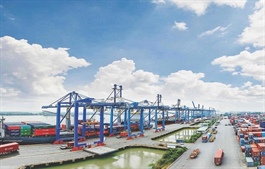Some business sectors see strong breakthrough
Some business sectors see strong breakthrough
Although the ongoing Covid-19 pandemic continues to challenge our day to day living, the stock market with still a robust group of shares, is expected to create a miracle in 2021. This may partly come about because many industry sectors made strong breakthroughs in 2020.
The pharmaceutical industry is much expected in the context of the prolonged pandemic.
|
Impact of pandemic
All throughout 2020, the Covid-19 pandemic had a strong impact on the profitability of the non-financial sector, such as manufacturing enterprises. The non-financial sector does not include banks, insurance, securities companies, and investment funds. This non-financial sector recorded a decrease of nearly 60% in profits after-tax in the first quarter, compared to the same period in 2019, when net revenue decreased by approximately 5%.
However, the non-financial sector has recorded a marked recovery since the second quarter, largely in raw materials, consumer goods, telecommunications, and information technology. This sector achieved positive growth in net revenue and profit after-tax in the last two quarters. Meanwhile, the financial sector and the banks, recorded positive results compared to the same period in 2019. The reason was the good growth of the banking sector from services rendered, in addition to income from securities investment, such as insurance cross-selling, payment services, brokerage activities, and bank guarantees.
On the other hand, the sectors that have not yet recovered include community utilities, consumer services, oil and gas, and the manufacturing industry. However, the oil and gas industry unexpectedly recovered when the after-tax profit in the third quarter increased impressively, compared to the previous quarter. In addition, the world oil price recovered in expectation of improved demand. Although they did not achieve positive growth in this quarter compared to the same period last year, net revenue and profit after-tax of pharmaceutical and medical industry, and community utilities, improved in 2020.
Benefit of low interest rate
The outbreak of the Covid-19 pandemic in 2020 raised concerns about the prospects of the stock market. However, according to analysts, the 2021 business landscape is more favorable for listed companies. For example, low interest rates create favorable conditions for businesses.
In the last months of 2020, almost all commercial banks reduced deposit rates. Many banks have now sharply reduced interest rates for long term deposits of over twelve months to less than 6% per year, while for short terms of less than six months in some banks to around 3% per year, much lower than the ceiling rate regulated by the State Bank of Vietnam. The continual reduction of interest rates in recent months has helped to create a cheap source of capital, thereby creating room to further reduce interest rates to support businesses to recover in the current scenario.
According to Rong Viet Securities (VDSC), in 2021, lending and deposit interest rates may continue to remain low as businesses need time to recover for at least one or two years after the Covid-19 pandemic has been fully contained. In addition, the fact that there was no sign of interest rate reversal of major banks in the last months of 2020 also supports the above argument.
Beneficial industries will be the group of industries with a high structure of loans on total assets, especially real estate enterprises. The real estate group is usually enterprises that use loans for large projects and benefit directly from the trend of falling interest rates. In addition, the real estate lending interest rate is at its lowest level in ten years, stimulating demand from potential home buyers. In addition, the supply will also be supported more by legal issues when the additional Construction Law, additional Investment Law, and Decree 148 will take effect in 2021.
Containing the disease
In 2021, the economy is forecast to remain stable. The recovery is looking positive, with unemployment rate falling to 2.5% after the June peak at 2.73%. Vietnam’s retail industry and services are expected to rebound in 2021 thanks to the recovery of consumer confidence. From now on, expectation is that purchasing power may become more stable in the near future.
When purchasing power gradually stabilizes and unemployment rate declines, the retail industry, which accounts for a large portion of 78% of the total retail sales of consumer goods and services, will be an attractive investment. In 2020, retail growth from negative April growth, rebounded strongly with eight consecutive months of growth. By the end of 2020, retail sales had grown two digits, up by 13%.
One industry that is expected to make higher recovery under the pandemic is the pharmaceutical industry. When the pandemic broke out, people moved cautiously and avoided crowded places, especially hospitals, and this industry saw a serious drop in revenue. Besides this, income of a large part of the population decreased substantially, causing negative impact on health spending in 2020. Therefore, when per capita income increases, the health care demand will gradually return, leading to rapid and sustainable growth in health spending in the long term.
Support of trade agreements
Vietnam’s economy will further open with the support of various trade agreements (FTAs) that will facilitate the transport of import and export goods across seaports. FTAs such as EVFTA, CPTPP, and UKVFTA will help increase Vietnam's exports such as seafoods and textiles. Besides, the advantage of cheap labor and competitive costs will also attract more Foreign Direct Investment (FDI) into Vietnam.
Vietnam is being considered a top destination as it possesses many advantages for a suitable business environment, besides also having a large domestic market, and a huge and increasingly high spending population. Vietnam has a similar advantage as China in terms of culture, politics and geographical location. These advantageous factors will help minimize the cost of production relocation, and maintain a close link with existing production facilities in China. The value of import and export in the following years is also forecast to grow positively. This situation shows that the pandemic has helped in accelerating the transfer of production facilities of multi-national enterprises into Vietnam, creating investment opportunities for the seaport industry.




























